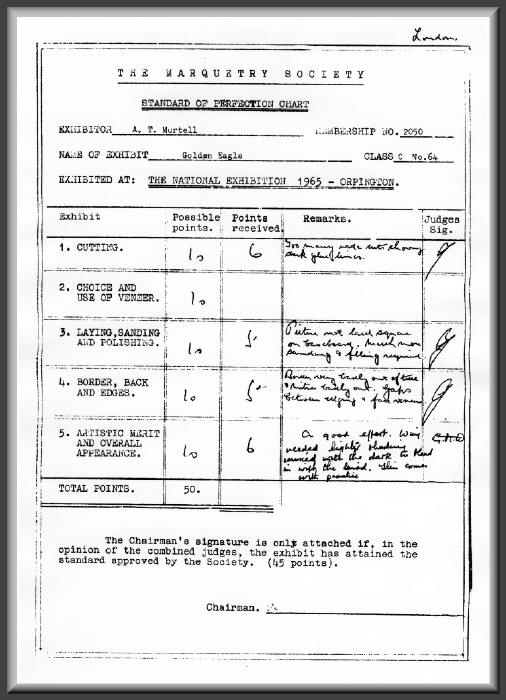| Judging Marquetry |
|
ON JUDGING
MARQUETRY |
|||||||||||||||||||||||||
|
Since my article in the April, 1956, Edition of THE MARQUETARIAN, quite a lot has been written and said on the above subject. This has prompted me to add further "coals to the fire"- having since that date judged other displays of Marquetry and, I think, learned a little more regarding this very controversial subject. Two esteemed colleagues have, in the Journal, expressed their views. both saying, "For one person to judge an Exhibition is asking too much." I disagree entirely; if that person is not governed by time, he should arrive at a hundred per cent. correct result, without argument. The above statement, of course, applies to present day Applied and Pictorial Marquetry - "Why?" do you ask-because over the past 4 years the general standard of the Craft has not improved. At each show I have attended it has been " child's play " to cast aside seventy-five per cent. of the exhibits because of some obvious fault, i.e.., brown paper backing; twisted base board, brought about by too thin a ply being used; the back of the picture not having been counter veneered; the edges having been painted; the mixture of dyed with natural veneers, etc... etc.. One writer asked why I didn't say more about the suitability of a subject for Marquetry-we all have our own ideas on this, and mine were as stated, Atom Plants, Sewage Farms, Gasworks and Railway Stations do not make for a pleasing picture. To answer the question as to whether a judge could be biased, the answer is NO, that is, a judge practising Marquetry himself would be fully acquainted with all aspects of the Craft, and should be open minded with regard to what he is looking at, even Gasworks! This brings me again to dyed veneers--which I don't like one little bit. However, in my opinion if a piece of work executed completely, repeat completely, in dyed woods is worthy, then it competes alongside it's "natural brothers." A separate section for work of this nature is not necessary, fortunately few people use these often ugly woods, but should an outstanding piece of work come along, then it takes it's chance with orthodox craftsmanship. Whilst the Society acknowledges "harewood," I find it difficult to understand why it is used so extensively these days. Kit sets use it for buildings-ridiculous I say-please in future restrict the use of this coloured wood to the pond, stream or dustbin! Another trend of the "modernists" is to make up a picture of as many small pieces as is humanly possible to cut-this I assure you carries no weight in a competition. The "old 'uns" used to say "let the wood do the work," and for good Marquetry this is still sound advice. Like everything else these days, the commercial dealers are, 1 think, partly to blame. Every month they advertise some newly imported exotic wood. The misinformed enthusiast says to himself “I must have some of that" and can't wait to use it, and so it goes on, month after month. Difficult woods to cut are used, because the book says they are new. One of the cleverest and most attractive pictures I have seen, was cut wholly from Walnut.. I have been asked if it matters how a piece of Marquetry is assembled, that is, the method of laying, gluing, cutting, polishing and so on. The answer is NO all the Judge is interested in is the finished product. Unfortunately he is not in a position to see this work in later years, when good workmanship will tell. To sum up, here are some "do's" and "don'ts" for the future competitor. |
|||||||||||||||||||||||||
|
|||||||||||||||||||||||||
|
|
|||||||||||||||||||||||||
|
A question that often arises, especially
after our Group or an inter-group competition is "What do judges
look for when they judge pictures?" Firstly, judges should bear in mind the
Marquetry Society's definition of Marquetry which is:- Whilst excellence in every regard is desirable, the various aspects of a Marquetry work should be ranked as follows:- |
|||||||||||||||||||||||||
|
|||||||||||||||||||||||||
|
A work that has used veneers economically should not necessarily be seen as inferior to one which contains a multitude of pieces of veneer. A single piece of veneer that works well should be rated just as highly as a complex multi-pieced representation that in itself works no better than a single well chosen piece. Minor indiscretions such as slight border mis-alignment, minor cutting errors, polishing imperfections or low quality hanging arrangements etc. should not in themselves be seen as a reason why an otherwise excellent work should be dismissed and not considered worthy of judging. The Societies definition of Marquetry should be borne in mind when considering the use and effectiveness of non natural veneers in a Marquetry exhibit. This applies to the use of dyed, man made, bleached or scorched veneers and the like. These, then, are the guidelines that the judges should be considering when judging a picture in a competition. These are also the guidelines that the marqueteer should bear in mind when cutting a picture. There are other rules which apply to the partiality of judges but these should not be of concern to the entrant. Hopefully these guidelines will help you when choosing and cutting and completing a picture or other piece for competition purposes and give a clear understanding of how the mind of a judge should be working when he is studying your latest masterpiece which you feel is destined for the 'Rosebowl' ! David Walker with thanks to the Marquetry Society |
|||||||||||||||||||||||||
 A "Standard of Perfection Chart" as originally issued by the Judges at a National Exhibition (if requested by the entrant). |
|||||||||||||||||||||||||


